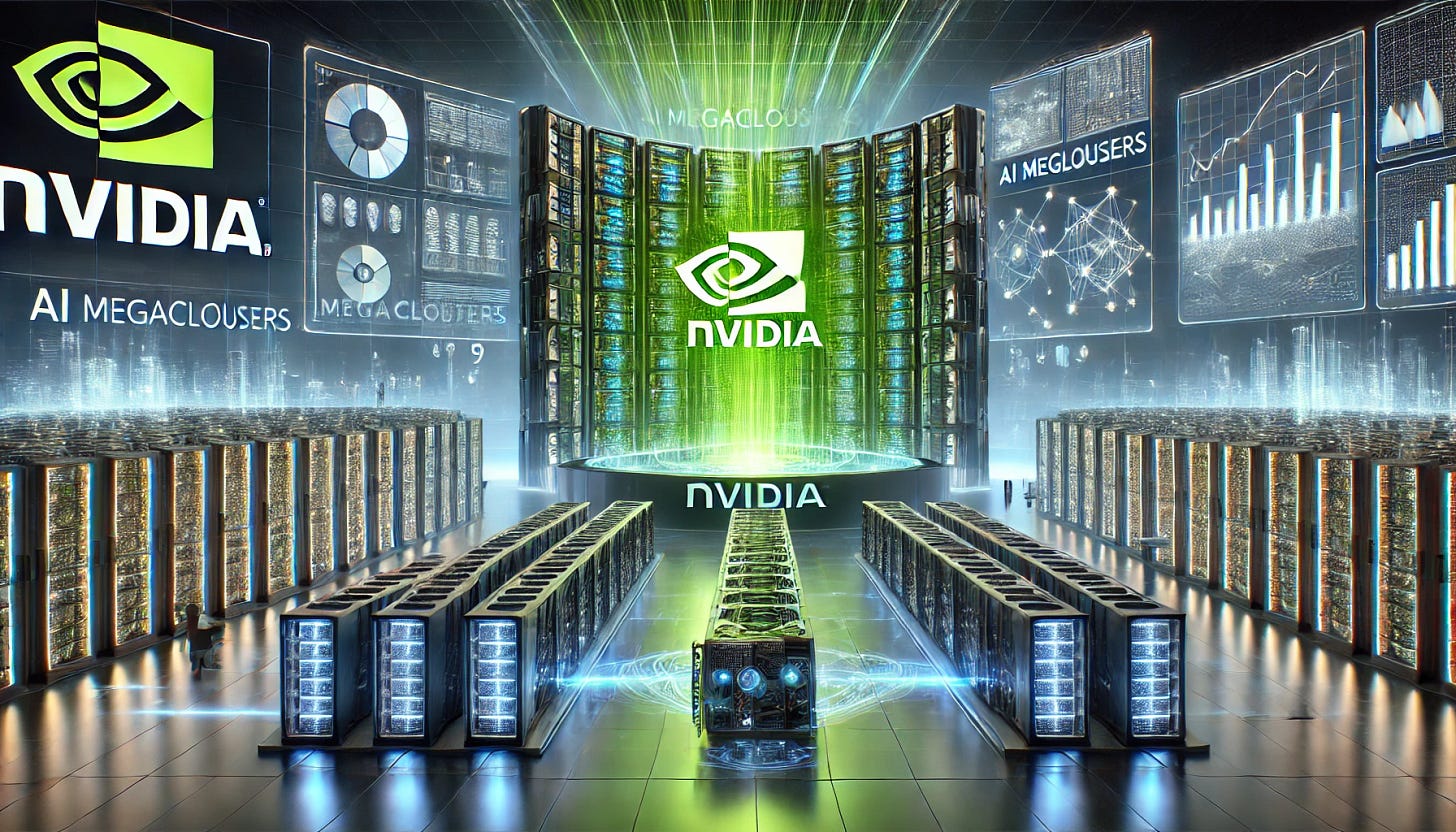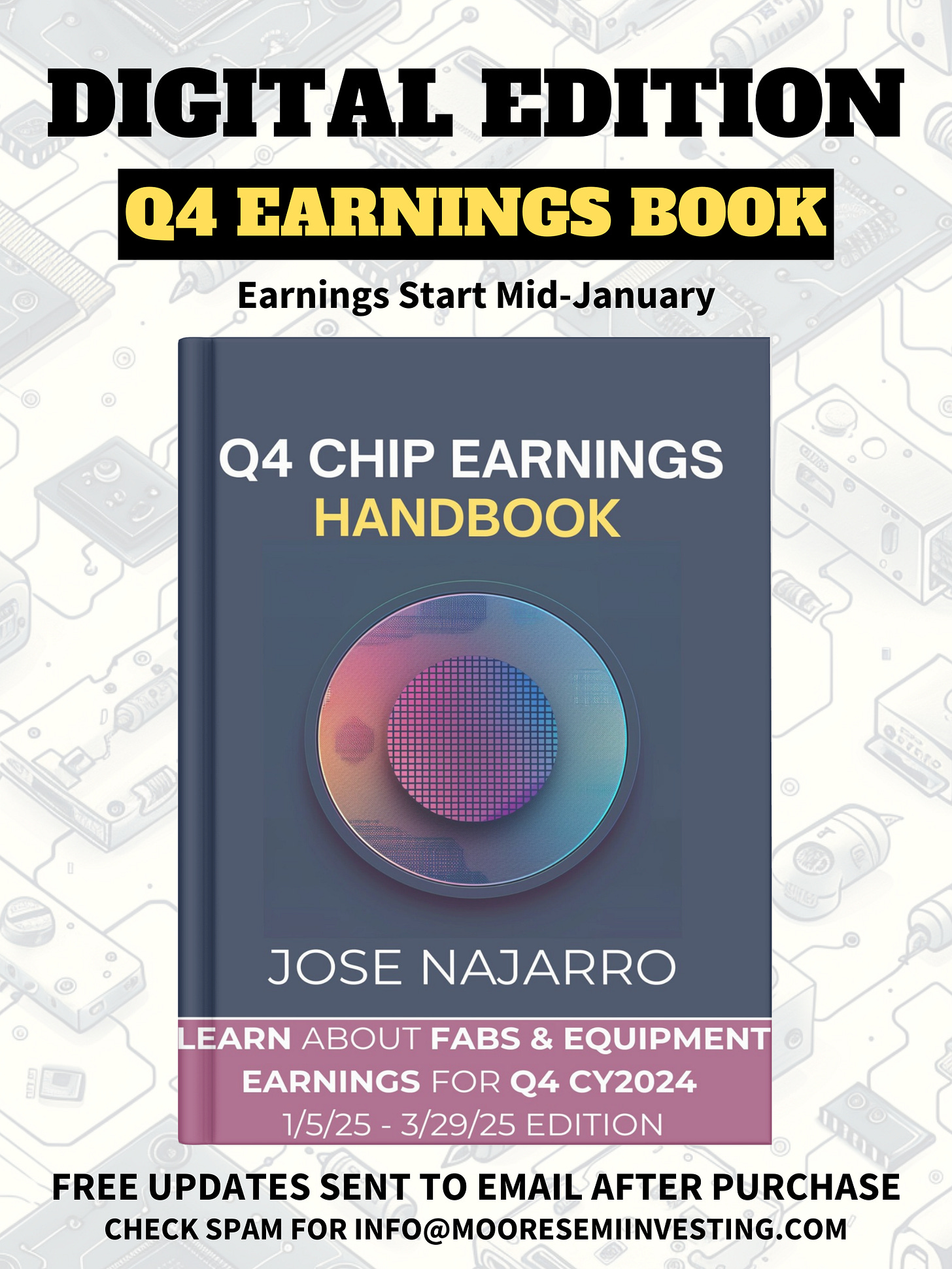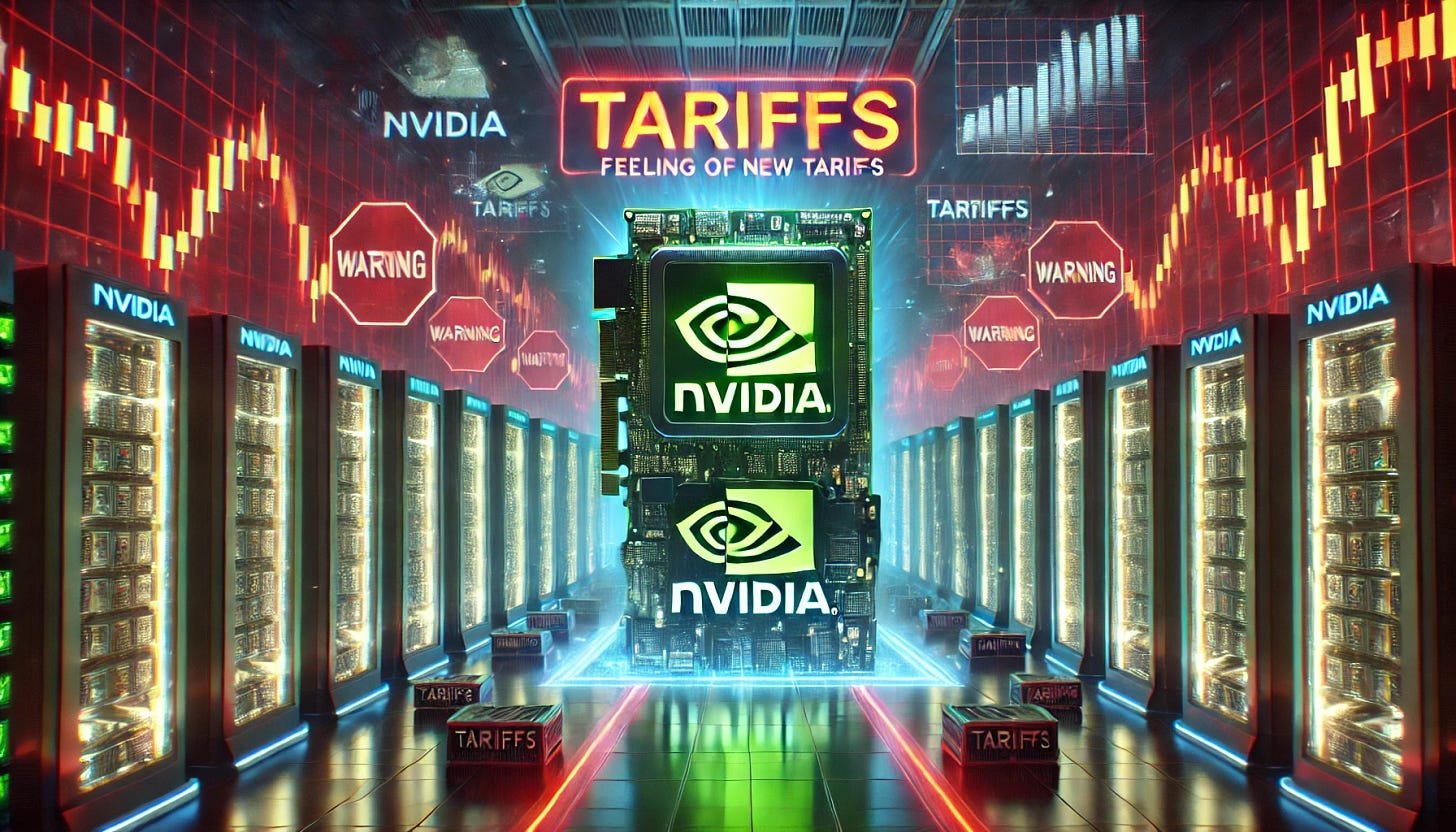Welcome, AI & Semiconductor Investors,
Nvidia is powering an unprecedented build-out of gigantic AI “megaclusters,” setting the stage for a new era of computing that could rival entire cities in energy demand.
We also dive into how fresh tariffs are rattling Nvidia’s bottom line and reveal Intel’s bold ambitions as it marches toward a transformative 2025—let’s dig in.
What The Chip Happened?
🔌Megacluster Mania: Nvidia’s Power Play in AI
📰 NVIDIA Feels the Tariff Tremors
💻Intel: Stepping Forward into 2025
Read time: 7 minutes
Nvidia (NASDAQ: NVDA)
🔌Megacluster Mania: Nvidia’s Power Play in AI
What The Chip: Nvidia is at the heart of an unprecedented build-out of massive AI computing clusters, often referred to as “megaclusters.” A recent discussion featuring Dylan Patel (SemiAnalysis) and Nathan Lambert (Allen Institute for AI) on the Lex Fridman Podcast highlighted just how big these data centers are getting and why Nvidia remains front and center in powering them.
Details:
🔌 Megawatt Madness: According to Dylan Patel, some next-gen AI data centers could draw over 1–2 gigawatts of power each (that’s more than entire cities). Nvidia’s GPUs are at the core, driving enormous capital spend on both training and inference clusters.
⚙️ Engineered for Scale: Nvidia’s ability to handle the “plumbing” (think custom interconnects, low-level CUDA optimizations, and advanced cooling) keeps them ahead of rivals. Management has stated, “We are at the tipping point of a new computing era,” underscoring their commitment to future generations of even more powerful chips.
🌏 Global Demand: Whether it’s OpenAI’s “Stargate” facility in Texas, xAI’s newly built data center in Memphis, or large-scale expansions at Meta and Google, everyone is buying Nvidia GPUs. Although export controls complicate Chinese access, demand remains scorching worldwide.
🚚 Supply Chain Watch: Dylan Patel emphasized that shipping tens of thousands of GPUs involves advanced logistics; there are even stories of “GPU smuggling” across borders. Still, Nvidia’s leadership in manufacturing scale and partnerships with TSMC keeps supply flowing.
🏗️ Data Center Arms Race: As multi-billion-dollar facilities sprout up, the race among AI heavyweights—OpenAI, xAI, Google, Meta—intensifies. Nvidia benefits directly from that rise in GPU-intensive infrastructure, powering everything from chatbots to AI-driven robotics.
💻 Programming Revolution: Nathan Lambert pointed out that advanced language models—trained on Nvidia hardware—are transforming coding and software engineering. It’s a near-future scenario where AI-assisted programming is the norm, further driving GPU adoption.
Why AI/Semiconductor Investors Should Care: Nvidia’s hardware lies at the core of nearly every serious AI initiative. As AI demands balloon from both training and inference, Nvidia’s leadership in GPU technology, advanced networking, and robust software support positions them to capture a large share of this fast-growing market. As these AI megaclusters scale, so too could Nvidia’s revenue opportunities—making NVDA a pivotal ticker to watch.
Moore Semiconductor Investing
📗 [NEW!!] Unlock Q4 Semiconductor Earnings --- 60% OFF (NEW EARNINGS)
What The Chip: Get a front-row seat to the financials shaping the semiconductor industry. This continuously updated e-book by Jose Najarro distills the latest Q4 quarterly insights—from wafer production trends to AI chip breakthroughs—into a single comprehensive resource.
Details:
🔵 Dynamic Updates: Start with giants like TSMC and ASML, then expand to 30+ companies as their Q4 2024 earnings roll in. Earnings are restarting!!
🔵 Broad Coverage: From traditional chipmakers to cutting-edge AI semiconductor players, get the full picture as it emerges.
Why AI/Semiconductor Investors Should Care: This evolving earnings handbook gives you a strategic edge. Understanding quarterly earnings data is crucial for gauging industry health, discovering new growth leaders, and aligning your investment approach with emerging technological waves.
Disclaimer: For educational and informational purposes only. Not financial advice. Consult with a qualified professional before making any investment decisions. Updates are only for the Quarter of Earnings.
NVIDIA (NASDAQ: NVDA)
📰 NVIDIA Feels the Tariff Tremors
What The Chip: Nvidia’s stock slid nearly 5% amid President Trump’s abrupt new tariffs on Canada, Mexico, and China. This move could ripple through the semiconductor supply chain, stirring short-term volatility for AI chip makers and investors.
Details:
🔴 Tariff Pressure: Over the weekend, Trump upped tariffs to 25% on imports from Mexico and Canada, with a 10% levy on goods from China. While semiconductors aren’t directly targeted, higher costs on assembled data processing equipment (like AI servers) may indirectly hurt Nvidia’s sales.
🌐 Export Restrictions Loom: Discussions are reportedly underway in Washington to expand restrictions on Nvidia’s H20 AI chips to China. This hits close to home as China accounts for roughly 17% of Nvidia’s sales.
🤔 DeepSeek’s Disruption: China’s DeepSeek claims AI compute reductions of up to 90–97%. Analyst Gil Luria called DeepSeek a “game changer,” potentially lowering the massive capital spending previously projected in AI—a possible headwind for high-end GPU demand.
🏗️ Server Assembly in Mexico: Big contract manufacturers, like Foxconn, are building large server assembly plants in Mexico. New tariffs could raise their costs, slowing AI server production. Stacy Rasgon from Bernstein warned that higher prices might dampen demand.
📉 Investor Jitters: Nvidia’s stock tumbled 17% in a single day last week over these AI efficiency concerns, one of the largest market cap drops in history. Followed by more volatility with the tariff news.
🗣️ Management Weighs In: “We remain committed to advancing AI technology while navigating the current trade climate,” said CEO Jensen Huang in a note shared with staff, reinforcing Nvidia’s long-term AI roadmap despite near-term market swings.
Why AI/Semiconductor Investors Should Care: Trade turbulence can spike short-term volatility, but it rarely breaks a well-founded investment thesis—unless tariffs meaningfully curb demand. AI and semiconductor investors should stay alert to changes in export policies and keep an eye on Big Tech’s continued investments in AI infrastructure. The combination of tariffs and new AI competition underscores the delicate balance between near-term headwinds and the massive long-term AI opportunity.
Intel Corporation (NASDAQ: INTC)
💻Intel: Stepping Forward into 2025
What The Chip: Intel reported its Q4 2024 earnings this past Thursday, posting slightly higher revenue and EPS than expected. The company sees challenges in data center and AI, but interim Co-CEOs Michelle C. Holthaus and David Zinsner emphasized execution improvements and cost efficiencies to regain competitiveness.
Details:
🔍 Upside Beat: Q4 revenue hit $14.3B, edging above analyst estimates of $13.8B, with non-GAAP EPS at $0.13 (versus $0.12 expected). “We suspect a portion of Q4 revenue upside was due to customers hedging against potential tariffs,” CFO David Zinsner said.
💻 PCs Remain Key: Intel still commands ~70% market share in PC CPUs, aiming to deliver 100+ million AI-enabled systems by the end of 2025. Core Ultra series and upcoming Panther Lake in late 2025 underscore Intel’s plans to lead in AI PCs.
🏭 Foundry Focus: Intel Foundry remains a heavy investment area, with a goal of hitting breakeven by 2027. Management wants to “earn the trust” of external chip customers by demonstrating consistent execution and advanced packaging capabilities.
⚙️ Data Center Pressure: Granite Rapids shows progress, but Intel acknowledges they still trail in certain AI workloads. The shift from Falcon Shores to Jaguar Shores, along with Gaudi accelerators, reflects the company’s effort to deliver more complete AI server solutions.
🇺🇸 CHIPS Act Boost: Intel secured an award up to $7.86B from the U.S. Department of Commerce for domestic capacity expansion, receiving $1.1B in Q4 and another $1.1B in January 2025.
🔋 Guidance Dip: Management guided Q1 2025 revenue between $11.7B and $12.7B amid seasonal weakness, ongoing inventory digestion, and macro concerns. Non-GAAP EPS is projected at $0.00 for Q1.
Why AI/Semiconductor Investors Should Care: Intel’s turnaround strategies in both product design and foundry services will shape the broader semiconductor landscape. With a significant PC footprint and renewed data center focus, Intel’s fortunes can influence everything from PC supply chains to national-level strategic manufacturing. For investors, Intel’s path to improved margins and AI competitiveness is a bellwether for the entire chip sector’s 2025–2026 outlook.
Youtube Channel - Jose Najarro Stocks
[NEW] Semiconductor Q4 Earnings Book — 60% OFF
X Account - @_Josenajarro
Disclaimer: This article is intended for educational and informational purposes only and should not be construed as investment advice. Always conduct your own research and consult with a qualified financial advisor before making any investment decisions.
The overview above provides key insights every investor should know, but subscribing to the premium tier unlocks deeper analysis to support your Semiconductor, AI, and Software journey. Behind the paywall, you’ll gain access to in-depth breakdowns of earnings reports, keynotes, and investor conferences across semiconductor, AI, and software companies. With multiple deep dives published weekly, it’s the ultimate resource for staying ahead in the market. Support the newsletter and elevate your investing expertise—subscribe today!
[Paid Subscribers] Intel’s Q4 2024: A Step Forward Amid Ongoing Transition
Executive Summary
Intel Corporation reported its fourth-quarter (Q4) 2024 financial results on January 30, 2025. The company generated $14.3 billion in revenue, a 7% year-over-year decline, yet above its prior guidance of $13.7 billion at the midpoint. Non-GAAP earnings per share (EPS) of $0.13 also exceeded the consensus expectation of $0.12. Intel’s interim Co-Chief Executive Officers (CEOs), Michelle Johnson Holthaus (who is also CEO of Intel Products) and David Zinsner (also the company’s Chief Financial Officer), emphasized that the quarter’s performance showed progress on the path to stronger execution, efficiency, and customer-driven product roadmaps.
Key takeaways from the call included:
Intel’s Client Computing Group (CCG) posted sequential revenue growth, partly driven by slowed inventory digestion and customers hedging against potential tariffs.
Intel Foundry (the newly established business segment encompassing Intel’s wafer manufacturing and foundry operations) improved its operating loss margin quarter-over-quarter, driven by product mix shifts and continued cost-reduction efforts.
Interim Co-CEO Michelle Holthaus reaffirmed Intel’s commitment to delivering competitive central processing units (CPUs) and accelerators in both the client PC and data center markets, with Panther Lake ramping in the second half of 2025 and a focus on new data center silicon to address artificial intelligence (AI) needs.
Some immediate actions have included optimizing spending, streamlining product roadmaps, and renewing Intel’s partnerships with the broader x86 ecosystem.
Management guided for first-quarter (Q1) 2025 revenue between $11.7 billion and $12.7 billion, reflecting seasonal weakness, macro uncertainties, ongoing inventory normalization, and heightened competition across major product lines. At the midpoint of the guidance range, Intel projects a 36% non-GAAP gross margin and breakeven non-GAAP EPS, with expectations that internal cost efficiencies and new product ramps in the second half of 2025 will support improved margins.
Overall, Intel’s Q4 results offered tangible evidence of incremental progress, with the leadership team highlighting several roadmaps, collaborations, and structural changes aimed at strengthening the company’s competitive position in the years ahead.
Growth Opportunities
During the call, Michelle Holthaus categorized Intel’s product portfolio into three main focus areas:
Client Edge (PCs)
Traditional Data Center
AI Data Center







